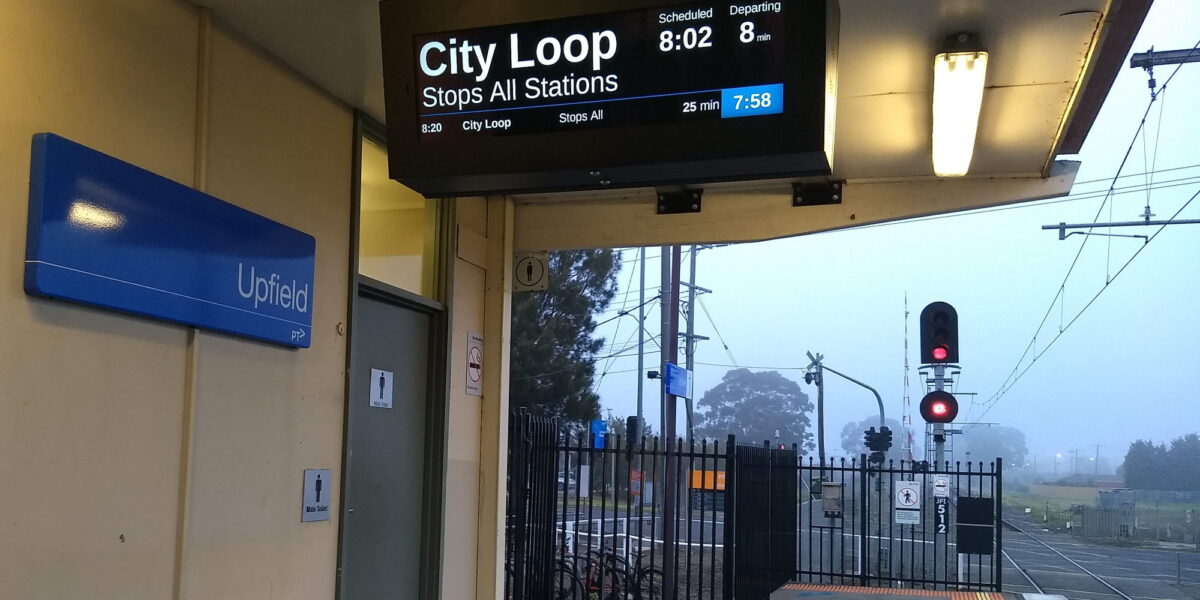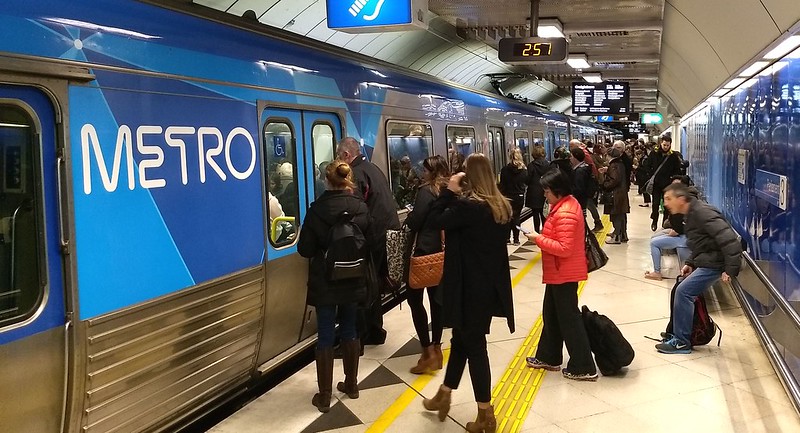Continuing from part one… going clockwise the next lines are the yellow ones on the rail map: the Sunbury, Craigieburn and Upfield lines.
Sunbury (St Albans) line
Until 2002, suburban trains ran to St Albans, with regional trains serving the stations beyond. The line was electrified in 2002 to Watergardens (Sydenham) and then in 2012 to Sunbury.
As noted in part one, until 1976 the line shared tracks from the City to Footscray with services to Newport (Williamstown and Geelong), Ballarat, and Bendigo.
Since 2015 when Regional Rail Link opened, Sunbury trains have had their own dedicated tracks as far as Sunshine, and when the Metro tunnel is completed in 2025, it will run through that, connected through to the Cranbourne/Pakenham line on the eastern side of the city.
| Sunbury line | 1924 | 1974 | 2020 |
|---|---|---|---|
| Service pattern | Mostly through-routed to/from Darling (now the Glen Waverley line) | Through-routed from the Burnley lines. Stopping all stations, including South Kensington, but most trains did not stop at White City, which has since closed. | About every second train only runs to Watergardens, so from there to Sunbury is comparatively low frequency outside peak hour. During peak, Watergardens trains stop all stations, and Sunbury trains run express between Sunshine and Footscray. |
| Running time (outbound midday) | Flinders Street-St Albans 31 minutes (including a stop at South Kensington) | Flinders St-St Albans 29 minutes (including a stop at South Kensington, but not White City) | Flinders St-St Albans 28 minutes (via Southern Cross) – trains do not stop at South Kensington, but do now stop at Ginifer (opened 1982) + 20 minutes to Sunbury |
| Peak hour | About every half-hour from St Albans to the City, with some additional trains starting at Sunshine | About every 10-15 minutes | About every 6 to 12 minutes depending on the station. Some trains express Sunshine to Footscray. |
| Weekday off-peak | About every 30 minutes, with some trains starting/ending at Sunshine | Every 20 minutes | Every 20 minutes to Watergardens, every 40 minutes to Sunbury |
| Weekday evenings | About every 30 minutes | Every 20 minutes | Every 30 minutes |
| Saturday off-peak | About every 30 minutes | Every 20 minutes | Every 20 minutes to Watergardens, every 40 minutes to Sunbury |
| Saturday evening | About every 30 minutes | Every 20 minutes | Every 30 minutes |
| Sunday morning | One service at around 10am. | Every 30 minutes | Every 40 minutes until 10am From 10am to 7pm, every 20 minutes to Watergardens, every 40 minutes to Sunbury |
| Sunday afternoon | About once an hour, with most trains only running as far as Sunshine, not to St Albans. | Every 30 minutes | Every 20 minutes to Watergardens, every 40 minutes to Sunbury |
| Sunday evening | About once an hour | Every 30 minutes | Every 30 minutes |
Craigieburn (Broadmeadows) line
The terminus was at Broadmeadows for decades, until electrification was extended to Craigieburn in 2007.
Infill stations opened at Oak Park in 1956 and Jacana in 1959.
Until the 1980s there was a connecting railway bus (numbered 903 in the 1974 timetable) from Broadmeadows to Coolaroo, which appears to have connected with most trains until about 7pm each weeknight, and on Saturdays until about 1pm. It’s still shown in the 1985 timetable, but was gone by 1988, and appears to have been replaced by bus route 541, a version of which runs to this day – yes it parallels the train line, but has more frequent stops so is likely to be better for some local trips.
| Craigieburn line | 1924 | 1974 | 2020 |
|---|---|---|---|
| Service pattern | Mostly through-routed with the Sandringham line. Most trains only ran as far as Essendon, with about every third or fourth train going as far as Broadmeadows. | All stations to Broadmeadows Mostly through-routed with Frankston | Most trains run all the way to Craigieburn, though in peak hour a few originate or terminate at Broadmeadows. In recent years, a handful of peak services ran as limited expresses, but these days they all stop at all stations. |
| Running time (outbound midday) | Flinders St-Broadmeadows 32 minutes | Flinders St-Broadmeadows 33 minutes (including additional stations at Oak Park and Jacana) | Flinders St-Broadmeadows 32 minutes (via Southern Cross) + 11 minutes to Craigieburn |
| Peak hour | Every 4-7 minutes to Essendon Every 30-60 minutes to Broadmeadows | About every 9 minutes, some trains terminating at Essendon | About every 6-8 minutes A handful of trains run to/from Broadmeadows |
| Weekday off-peak | Every 15 minutes to Essendon Every 45 minutes to Broadmeadows | Every 20 minutes | Every 20 minutes |
| Weekday evenings | Every 15 minutes to Essendon Every 45 minutes to Broadmeadows | Every 20 minutes | Every 30 minutes |
| Saturday off-peak | Every 15 minutes to Essendon Every 45 minutes to Broadmeadows | Every 20 minutes | Every 20 minutes |
| Saturday evening | Every 15 minutes to Essendon Every 45 minutes to Broadmeadows | Every 20 minutes | Every 30 minutes |
| Sunday morning | Only 3 services from Essendon, including 1 from Broadmeadows, then nothing until after lunch | Every 30 minutes | Every 40 minutes until 10am From 10am to 7pm, every 20 minutes |
| Sunday afternoon | Every 15 minutes to Essendon Every 45 minutes to Broadmeadows | Every 30 minutes | Every 20 minutes |
| Sunday evening | Every 15 minutes to Essendon Every 45 minutes to Broadmeadows | Every 30 minutes | Every 30 minutes |
Upfield (Fawkner) line
Electrified to Fawkner in 1920, and electrified in 1959 to Gowrie and Upfield to support the Ford factory.
An additional station, North Brunswick, later named Anstey, was added in 1926.
In 2020: There is still single track from Gowrie to Upfield, which (along with the inability to turn back trains at Gowrie) causes problems with trains often terminated short at Coburg when there are delays, and limits service frequency (though CBD capacity is also an issue in peak hour until the Metro tunnel opens).
Sadly the single track/Gowrie turnback hasn’t been fixed during either of the two level crossing removal projects on the line in recent years, though the Camp Road crossing removal left space for it.
- Update 3/12/2020: Some interesting reading here on the 1988 proposal to convert the Upfield line to light rail
| Upfield line | 1924 | 1974 | 2020 |
|---|---|---|---|
| Service pattern | Mostly through-routed to Kew (now closed) which was a branch from the Ringwood line at Hawthorn. | At most times, about every second train terminated/originated at Gowrie, one stop short of Upfield Mostly through-routed to Glen Waverley | All trains are scheduled to run all the way to Upfield. |
| Running time (outbound midday) | Flinders St-Fawkner 26 minutes (this is before Anstey station was opened) | Flinders St-Fawkner 29 minutes + 9 minutes to Upfield | Flinders St-Fawkner 28 minutes + 7 minutes to Upfield |
| Peak hour | About every 10 minutes from Coburg to the City, with roughly every third train extended to Fawkner | About every 15-20 minutes | Every 18-20 minutes |
| Weekday off-peak | About every 15 minutes from Coburg to the City, with about every second train extended to Fawkner | Every 20 minutes | Every 20 minutes |
| Weekday evenings | As for weekday off-peak | Every 20 minutes | Every 30 minutes |
| Saturday off-peak | About every 15 minutes from Coburg to the City, with about every second or third train extended to Fawkner | Every 20 minutes | Every 20 minutes |
| Saturday evening | About every 15 minutes from Coburg to the City, with about every second train extended to Fawkner | Every 20 minutes | Every 30 minutes |
| Sunday morning | Two services at around 10am. | No service | Every 40 minutes until 10am From 10am to 7pm, every 20 minutes |
| Sunday afternoon | About every 15 minutes Coburg to the City, with every third train extended to Fawkner | No service | Every 20 minutes |
| Sunday evening | As for Sunday afternoon | No service | Every 30 minutes |
Conclusion
The Sunbury line mostly has more services now than it did 50 and 100 years ago – particularly in peak hour – reflecting population growth.
On the Craigieburn and Upfield lines, the inner sections (as far as Essendon and Coburg) were more frequent in the 1920s, at all times of day, but the more sparsely populated outer sections were less frequent.
Upfield line Sunday services were non-existent in the 1970s, having been cut in 1971, with passengers instead directed to the mostly-parallel tram 19 as far as North Coburg, then a bus service the rest of the way. By the 1980s this was also the case on Monday to Saturday evenings, but after nearly being closed completely, the line was upgraded to a full service in the 1990s.
On the Craigieburn and Upfield lines (as on most of the rail network), in 2020, Monday to Saturday evening services remain less frequent than in the 1920s and 1970s, today being mostly every half-hour.
Let’s hope that changes before too long. The Metro tunnel (which will be served by the Sunbury line) will make space for more peak services on all these lines.
But it’s almost unimaginable that a new rail tunnel costing many billions of dollars would have a service every few minutes in peak, but only every 30 minutes in the evening.
- Edit: added mention of the lack of ability to turn back trains at Gowrie as an issue on the Upfield line



5 replies on “Were there more trains 100 years ago? (Part two)”
Very interesting series of posts Daniel. Interesting that Craigieburn being eventually through routed to Frankston is a return to past programming. Also amazingly the City Loop was bad news for us as well.
[…] of course, no matter how great the infrastructure, the service – especially on the Upfield line – also needs improvement. Trains only every 20 minutes is not terrific in this day and […]
[…] I blogged about it here, pointing out that yes they might lose their comfy V/Line trains, but overall service levels would rise, with more frequent services right across the […]
[…] (in 2018-19) was a fair bit lower, 279,700, but probably more concentrated in peak hours. There are more trains running now than in the 1920s, but off-peak service needs to be more frequent to compete with widespread […]
[…] the third post comparing old (1924 and 1974) vs current train timetables. Parts one and two covered the western and northwestern lines. Going clockwise the next lines are the red ones on the […]